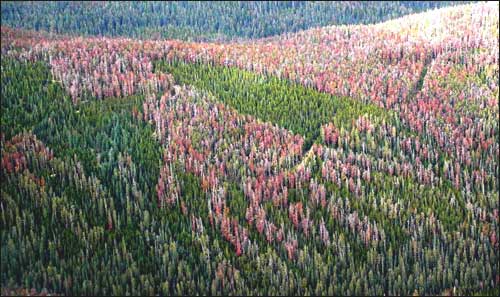Insect Invasion Bring Destruction to Southern Pine Forests
By: Amos S. Eno
Posted on:12/11/2013 Updated:12/13/2013The southern pine beetle, cousin of the more popular western pine beetle, is responsible for the death of millions of pine trees from Texas to New Jersey.
In recent years, devastation caused by the western pine beetle (Dendroctonus brevicomis) to pine forests in the Western United States has received much media coverage, but pine trees in the South and Mid-Atlantic are not immune to beetle infestations either. Published on December 1, the New York Times article In New Jersey Pines, Trouble Arrives on Six Legs details how the predicament facing New Jersey’s pine forests due to the spread of the southern pine beetle (Dendroctonus frontalis), which is similar to, but distinct from the western pine beetle, mirrors the situation in western forests.
While the beetle has made recurring attempts to infest New Jersey’s pine forests in the past, the severity of the past decade’s infestations are unprecedented in recent memory. Much like in the west, scientists suggest that the rise in outbreaks is due to warming temperatures. New Jersey’s average temperature has warmed by about 2.3 degrees Fahrenheit over the past century, but that is not the number that matters.
 In recent years, devastation caused by the western pine beetle (Dendroctonus brevicomis) to pine forests in the Western United States has received much media coverage, but pine trees in the South and Mid-Atlantic are not immune to beetle infestations either. Published on December 1, the New York Times article In New Jersey Pines, Trouble Arrives on Six Legs details how the predicament facing New Jersey’s pine forests due to the spread of the southern pine beetle (Dendroctonus frontalis), which is similar to, but distinct from the western pine beetle, mirrors the situation in western forests.
In recent years, devastation caused by the western pine beetle (Dendroctonus brevicomis) to pine forests in the Western United States has received much media coverage, but pine trees in the South and Mid-Atlantic are not immune to beetle infestations either. Published on December 1, the New York Times article In New Jersey Pines, Trouble Arrives on Six Legs details how the predicament facing New Jersey’s pine forests due to the spread of the southern pine beetle (Dendroctonus frontalis), which is similar to, but distinct from the western pine beetle, mirrors the situation in western forests.
While the beetle has made recurring attempts to infest New Jersey’s pine forests in the past, the severity of the past decade’s infestations are unprecedented in recent memory. Much like in the west, scientists suggest that the rise in outbreaks is due to warming temperatures. New Jersey’s average temperature has warmed by about 2.3 degrees Fahrenheit over the past century, but that is not the number that matters.
Bitterly cold winters were responsible for keeping the beetle in check in the past – winter nights of about 8 degrees below zero are required to kill the beetle. That does not mean it has to get that cold every year, but such temperatures used to occur several times per decade. However, the last night that cold in New Jersey’s Pinelands was in 1996 – severe beetle outbreaks began five years later.
However, unlike the highly publicized beetle outbreaks in the west, New Jersey’s struggles have gone largely unnoticed. There is a similar lack of action to confront the problem in the state. Bob Williams, a Certified Forester working in New Jersey whom Resources First Foundation has interviewed for our blog in the past, suggests the state, and private forest owners, need to adopt tactics such as prescribed burning and selective thinning to remove dead or weak trees to leave more space for the healthy ones to thrive. You see, healthy trees can defend themselves from insect invaders, but weaker trees are vulnerable.
Described in the article Virginia’s Southern Pine Beetle Prevention Program Focuses on the Positive by Joseph M. Smith, Virginia is taking an approach similar to the one Williams described. The Virginia Department of Forestry is working on a prevention program protect and restore healthy forests, which includes, but is not limited to the mitigation of southern pine beetle outbreaks. The plan subsidizes actions taken by private landowners, such as cost-share programs to incentive pre-commercial thinning (PCT) and restoration that includes, planting and prescribed burning.
In the western U.S., the USDA has found a positive use for trees killed by the western pine and bark beetles – converting them to biofuel. The $10 million program, headed by Colorado State University, includes additional partners in Colorado, Idaho, Montana and Wyoming. Hopefully, a similar program will be adopted in areas affected by the southern pine beetle anywhere prescribed thinning is used. Why let all of that wood go to waste?
Winter is now fully underway throughout the country, and hopefully we will receive temperatures cold enough to kill pines beetles and give pines forests some needed reprieve.
Photo courtesy of the U.S. Forest Service.
Feedback
re: Insect Invasion Bring Destruction to Southern Pine ForestsBy: John Zylstra, Forester on: 12/13/2013Listen to Bob Williams, he has a clear understanding of how climate change has brought pine beetles northward, a success story in Delaware where these types of forests are in fact managed and reduced the beetle impact and govt. preservation of the forests (no management), including fire suppression in the NJ Pinelands.
 Sign In
Sign In
 Sign In
Sign In
